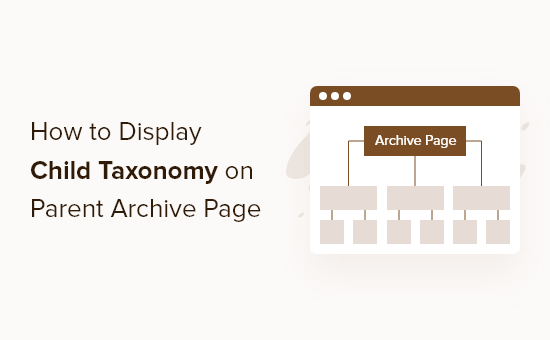How to display child categories on archive page of parent categories
Do you want to know how to display child categories on the parent category archive page?
When you customize a classification archive page, you may need to do this to make it more useful to your visitors.
In this article, we will show you how to easily display child categories on the parent category archive page.

Why do subcategories appear on parent category archive page?
By displaying all child categories on the parent category archive page, you can make them less generic and more useful to visitors.
For example, if you run a WordPress blog about books and have a taxonomy called "Theme", you can add sub-taxonomy such as "novel", "non-fiction" so that your readers can easily sort your books.
When you have a lot of content, this not only makes it easier for you to stay organized, but it also helps your visitors find relevant content faster.
For more details on using taxonomy, see the guide on how to create custom taxonomy in WordPress.
That being said, let's show you how to display child categories on the parent category archive page.
Show child categories on parent category archive page
This tutorial requires some basic understanding of how to add code to WordPress. For more details, see our beginner's guide to pasting web clips into WordPress.
Then, you need to find the classification template file for your WordPress theme. It is usually named with a similar name taxonomy-{taxonomyname}.php.
If you create a custom taxonomy called "Books", the name will be taxonomy-books.php. If you don't have this file, you need to create it first.
To learn more, see our WordPress Template Hierarchy cheat sheet to help find the categorical theme template files you need to edit.
Once you find the correct classification template file, you just need to add the following code to where you want to display the list:

Note how it simply lists all sub-taxonomy of single parent taxonomy. In this case, it shows the different book topics that exist in our parent category.
For more details on custom classification pages, see our guide on how to display current classification titles, URLs, and more in WordPress.
We hope this article helps you understand how to display child categories on the parent category archive page. You might also want to check out our guide on the differences between domain names and web hosting and our expert picks of the best GoDaddy alternatives.
The above is the detailed content of How to display child categories on archive page of parent categories. For more information, please follow other related articles on the PHP Chinese website!

Hot AI Tools

Undresser.AI Undress
AI-powered app for creating realistic nude photos

AI Clothes Remover
Online AI tool for removing clothes from photos.

Undress AI Tool
Undress images for free

Clothoff.io
AI clothes remover

Video Face Swap
Swap faces in any video effortlessly with our completely free AI face swap tool!

Hot Article

Hot Tools

Notepad++7.3.1
Easy-to-use and free code editor

SublimeText3 Chinese version
Chinese version, very easy to use

Zend Studio 13.0.1
Powerful PHP integrated development environment

Dreamweaver CS6
Visual web development tools

SublimeText3 Mac version
God-level code editing software (SublimeText3)

Hot Topics
 1664
1664
 14
14
 1421
1421
 52
52
 1315
1315
 25
25
 1266
1266
 29
29
 1239
1239
 24
24
 What is the difference between php framework laravel and yii
Apr 30, 2025 pm 02:24 PM
What is the difference between php framework laravel and yii
Apr 30, 2025 pm 02:24 PM
The main differences between Laravel and Yii are design concepts, functional characteristics and usage scenarios. 1.Laravel focuses on the simplicity and pleasure of development, and provides rich functions such as EloquentORM and Artisan tools, suitable for rapid development and beginners. 2.Yii emphasizes performance and efficiency, is suitable for high-load applications, and provides efficient ActiveRecord and cache systems, but has a steep learning curve.
 Steps to add and delete fields to MySQL tables
Apr 29, 2025 pm 04:15 PM
Steps to add and delete fields to MySQL tables
Apr 29, 2025 pm 04:15 PM
In MySQL, add fields using ALTERTABLEtable_nameADDCOLUMNnew_columnVARCHAR(255)AFTERexisting_column, delete fields using ALTERTABLEtable_nameDROPCOLUMNcolumn_to_drop. When adding fields, you need to specify a location to optimize query performance and data structure; before deleting fields, you need to confirm that the operation is irreversible; modifying table structure using online DDL, backup data, test environment, and low-load time periods is performance optimization and best practice.
 How to download, install and register the Hong Kong Digital Currency Exchange app 2025
Apr 30, 2025 pm 07:18 PM
How to download, install and register the Hong Kong Digital Currency Exchange app 2025
Apr 30, 2025 pm 07:18 PM
The download, installation and registration process of the Hong Kong Digital Currency Exchange app is very simple. Users can quickly obtain and use this app through the official app download link provided in this article. This article will introduce in detail how to download, install and register the Hong Kong Digital Currency Exchange app to ensure that every user can complete the operation smoothly.
 How to process sensor data in C?
Apr 28, 2025 pm 10:00 PM
How to process sensor data in C?
Apr 28, 2025 pm 10:00 PM
C is suitable for processing sensor data due to its high performance and low-level control capabilities. Specific steps include: 1. Data collection: Obtain data through the hardware interface. 2. Data analysis: convert the original data into available information. 3. Data processing: filtering and smoothing processing. 4. Data storage: Save data to a file or database. 5. Real-time processing: Ensure the efficient and low latency of the code.
 uniswap on-chain withdrawal
Apr 30, 2025 pm 07:03 PM
uniswap on-chain withdrawal
Apr 30, 2025 pm 07:03 PM
Uniswap users can withdraw tokens from liquidity pools to their wallets to ensure asset security and liquidity. The process requires gas fees and is affected by network congestion.
 Specify character sets and collations when creating databases in MySQL
Apr 29, 2025 pm 03:51 PM
Specify character sets and collations when creating databases in MySQL
Apr 29, 2025 pm 03:51 PM
When creating a database in MySQL, character sets and collation rules should be specified to ensure data accuracy and improve query performance. 1) Use the CREATEDATABASEmy_databaseCHARACTERSETutf8mb4COLLATIONutf8mb4_unicode_ci command to create a database, select the utf8mb4 character set and utf8mb4_unicode_ci collation. 2) utf8mb4 supports more Unicode characters, while utf8mb4_unicode_ci provides case-insensitive comparisons. 3) Ensure that the application layer and database layer use the same character set and collation rules to avoid potential problems.
 Why can some websites achieve mouse scrolling and penetration effect, while others cannot?
Apr 30, 2025 pm 03:03 PM
Why can some websites achieve mouse scrolling and penetration effect, while others cannot?
Apr 30, 2025 pm 03:03 PM
Exploring the implementation principle of mouse scrolling events When browsing some websites, you may notice that some page elements still allow scrolling the entire page when the mouse is hovering...
 XRP Price Forecast: Does the token surpass its recent $2.35 high?
Apr 30, 2025 pm 05:30 PM
XRP Price Forecast: Does the token surpass its recent $2.35 high?
Apr 30, 2025 pm 05:30 PM
XRP's 50-day exponential moving average (EMA) has become its key support area, with the current 20-day EMA of $2.17, showing reliability in past pullbacks. XRP is currently priced at $2.28, and has recently hit $2.20 for the 50-day EMA. The token also encountered a resistance of $2.50, which limited the upward momentum on the last trading day of April. The 50-day EMA provides support for the token, while the 20-day EMA, currently at $2.17, has shown resilience in past pullbacks. These levels are crucial to determine whether XRP will consolidate or face collapse in the near term. The moving average convergence divergence (MACD) indicator shows weak momentum in the short term. On the daily chart, MACD shows blue M




